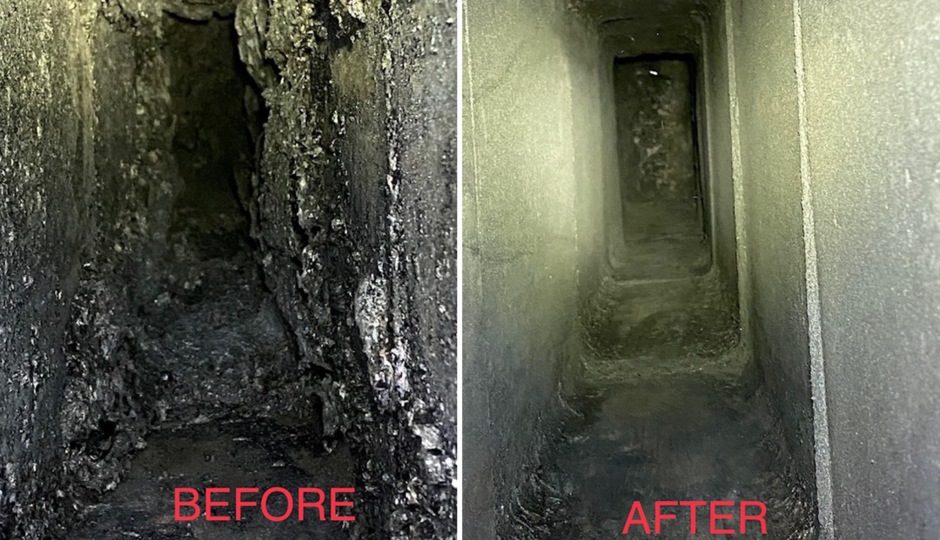
Contact Us
Soot Solutions Chimney Cleaning
Miller Place, NY 11764
Phone: 1-631-403-4755
E-mail: sootsolutions@gmail.com
Click the facebook icon below to check out our recent projects and special offers on our facebook page. ↓
CHIMNEY FIRE PREVENTION: Having your chimney cleaned is a great way to stay proactive and prevent yourself from having a chimney fire. However, chimney fire prevention starts with YOU! The risk of having a chimney fire varies based on how often it’s cleaned and what you burn. Simply put, the cleaner and drier the wood you are burning, the less likely you will have a chimney fire. While a chimney cleaning is a good way to get your chimney back into proper burning condition, it is only the beginning. It is still possible to have a chimney fire after a cleaning if you burn wood that has a high moisture content, wood with chemicals in it, or wood containing sap. In addition, too much paper, cardboard, or any other household trash can easily lead to a chimney fire. Anything other than good, dry, hardwood will leave deposits in your chimney that can immediately lead to a fire. This is true for ALL wood burning chimneys (fireplaces, wood stoves, wood stove inserts, etc.). Depending on how often you burn, it is a good idea to have your chimney cleaned annually. We recommend a cleaning in the spring or early summer to avoid any unwanted odors caused by hot, humid air entering the chimney in the summertime, also to avoid a long wait time as the winter season is our busy season. During our busy season it is not uncommon for us to be scheduled out over a month or more.
TESTING THE MOISTURE CONTENT OF FIREWOOD: The ONLY way to accurately and properly test your firewood, is with the use of a moisture meter. DO NOT ASSUME YOUR WOOD IS DRY. Wood takes a long time to properly season, and needs to be both processed and stored correctly to achieve desired moisture content. To test with a moisture meter, take a “seasoned”, already cut-to-size piece and split it down the middle, using the metal probes of the meter poke into the wood and observe the reading. You want to collect the results from the “core” of the wood. Putting the meter on the outside of a piece of wood will not give you an accurate measurement. If the reading is 20% or higher, the wood is considered unburnable and will cause various issues if burned. Improperly seasoned wood produces up to 10X’s more smoke than seasoned wood, and the large volume of excess smoke may overwhelm your chimney and or cause a smoke/odor issue in your home. Wet wood will not burn as hot and will cause a harmful buildup in your chimney. ONLY burn wood with a moisture reading of 20% or lower. If you prefer, you may burn KILN DRIED firewood or ENVIRO BRICKS. Usually more expensive due to the drying/production process used, but they will burn cleaner and much better than traditionally seasoned wood. Duraflame type logs are also fine when used in moderation.
TIPS AND TRICKS TO STARTING A SUCCESSFUL FIRE: Whether you’re building a fire in a fireplace, a wood stove, or a wood stove insert, the process is the same. Make sure to fully open the damper of the chimney or chimney pipe. Be sure to use clean dry kindling, newspaper, or whichever fire stater you prefer. Start with very small pieces of wood stacked “criss-cross” so air can get to the wood, followed by slightly larger pieces at the top. DO NOT USE STICKS YOU FIND ON YOUR LAWN. In some cases, if your chimney does not draft well or if it is very windy/damp out, you may need to do what is known as “priming the chimney flue”. This means you introduce hot air into your chimney in order to get cold air out, prior to lighting your fire. With the proper draft, smokey air caused by the fire will escape up the chimney rather than back into your home. (There are many ways to do this, check out Youtube or Google for additional methods that may be helpful). An easy way to prime your chimney is to open the damper, place a large lit candle in the firebox for 5-10 minutes prior to lighting the fire, you can also use a torch or a lighter to create heat in the chimney before lighting your fire, or roll up some newspaper and hold it up in the fire box. The goal is to start the process of hot air going up your chimney rather than the cold, outside air coming down. Keep in mind, there may be a few days a year where outside weather conditions are too unfavorable, and it is not possible to establish a proper draft to light a fire. Unfortunately, this is not uncommon.

